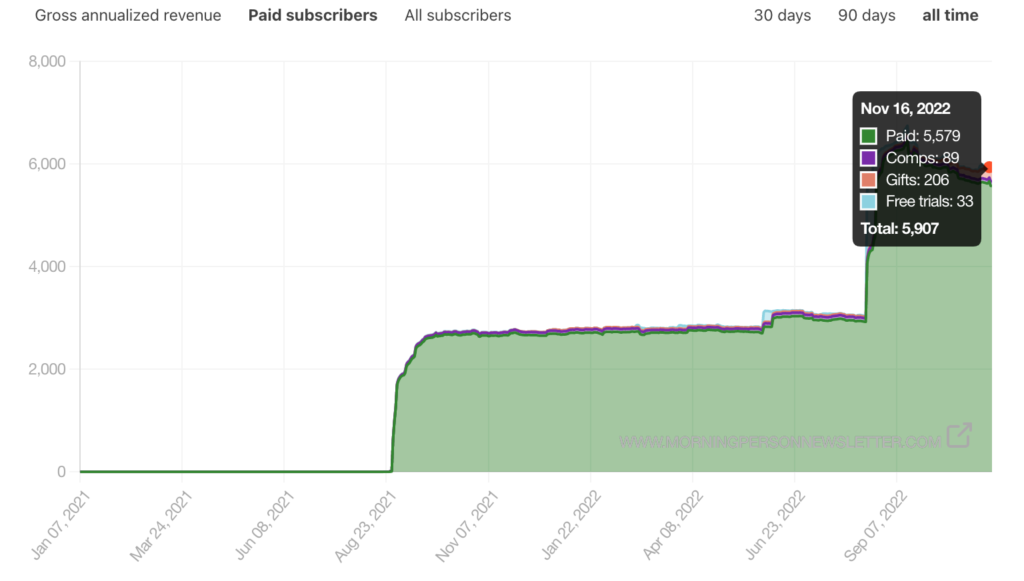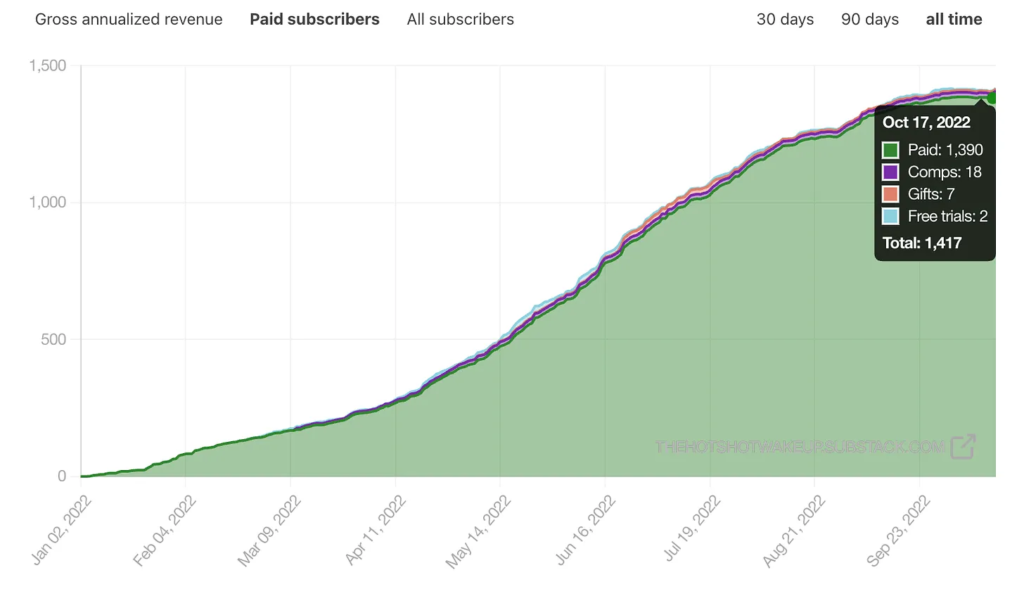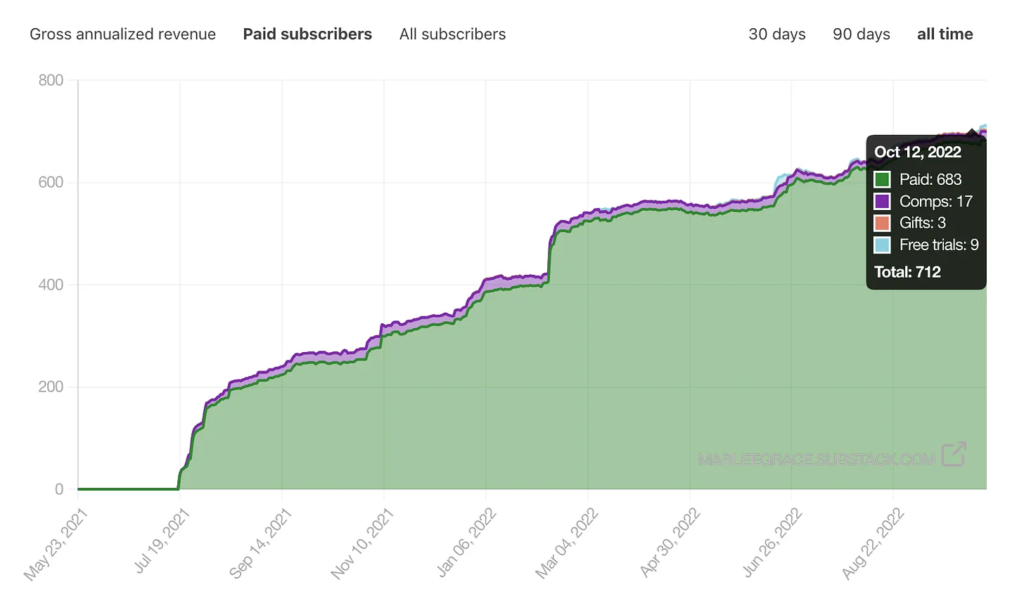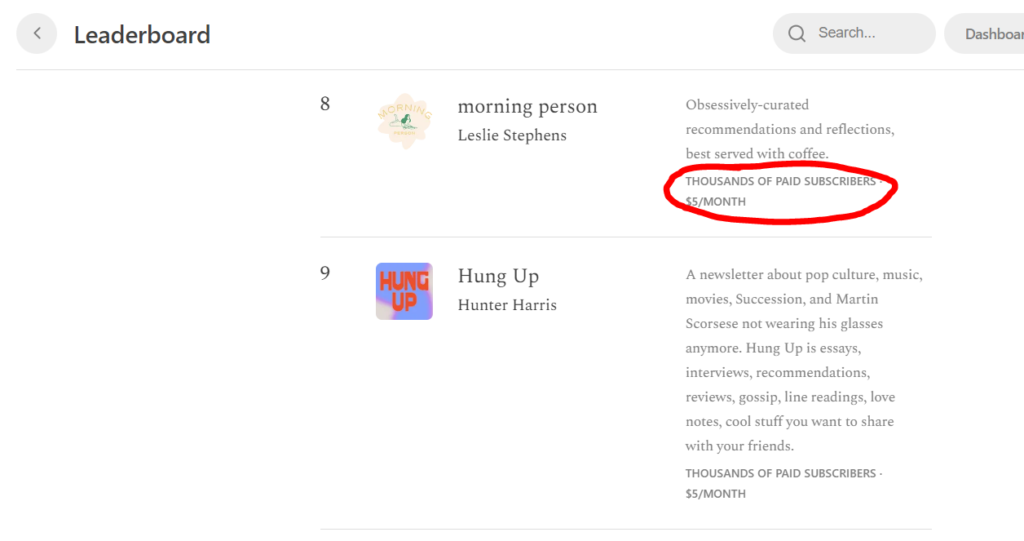Last updated April 16, 2025
How ‘Morning Person’ Grew to $25,000 Monthly Revenue
- Newsletter: morning person
- Writer: Leslie Stephens
- Subscribers: 5,000+
- Earnings: $25,000+ monthly ($5 subscription fee)
The beginning
Leslie already had 20,000 followers on Instagram when she launched her Substack blog in August 2021. She was known for her work with ‘Cupcakes and Cashmere,’ which gave her a solid start.
By December 2022, Substack featured an article about her, noting she had over 5,000 paid subscribers. At $5 per month for each subscriber, that means her newsletter was bringing in over $25,000 monthly before Substack took its share.

She put a lot of work into her newsletter, revising drafts carefully before sharing them. Her announcement on Instagram about ‘The Morning Person’ newsletter got close to 2,000 likes. Her existing following definitely helped kickstart her Substack success.

Leslie believes in being open with her readers, like when she shared about her divorce, which led to hundreds of supportive emails from her subscribers.
Leslie also credits her growth to the support from other Substack writers. She recommends building connections with them because it’s often a two-way street — they support you back.
Not relying on sponsorships or affiliate links means Leslie can offer honest, unbiased content. This has set her apart from many others and built a trusting relationship with her subscribers.
Free vs paid content
In every newsletter Leslie sends out, she follows a simple plan. She includes three main points. The first two are free for all readers, but the third is exclusive to paid subscribers. Substack’s platform has a feature where you can choose to make some of your newsletter content only available to those who pay.

How ‘The Hotshot Wake Up’ Grew to $8,000 Monthly Revenue
- Newsletter: The Hotshot Wake Up
- Writer: Tim Casperson
- Paid subscribers: 1,440+
- Earnings: $8,000 monthly ($6 subscription fee)
The content
Substack’s “The Hotshot Wake Up” is all about wildfires and the brave lives of wildland firefighters. It gives you the scoop directly from the front lines and keeps firefighters and folks at home in the know. It’s also got tips on staying fit and dealing with the stress that comes with tough jobs.
Tim is super committed. He gets content out there 4-5 times a week, including a couple of podcasts. Here’s what his week typically looks like:
- Monday kicks off with a workout post, great for those who love staying active and getting outdoors.
- On Tuesday, he drops a podcast called the midweek-brief, where he chats about the latest in wildfires and outdoor life.
- Somewhere between Wednesday and Thursday, Tim shares a personal story, the latest wildfire news, or his own insights on recent events.
- Come Friday, you can catch his wildfire update in podcast form, giving you the lowdown on what fires are burning and other news.
- The weekend might bring a tasty, healthy recipe your way.
The beginning
Tim started sharing wildfire updates and a touch of humor on Instagram for his firefighting buddies. That was just the start. Seeing a need for real talk and experience-based insights, he moved to Substack.
He kicked things off in January 2022 and introduced a paid option a few weeks in. By November 2022, he had 5,700 free subscribers and 1,440 paid ones, pulling in about $8,640 a month. Fast forward to 2023, and his free subscribers have shot up to 13,000.

Free vs paid content
Tim’s about page states, “Monthly subscriptions to the Substack support firefighters through charitable donations to help injured firefighters and their families in need.” This suggests all the subscription money goes to charity. But it’s not mentioned if he keeps any for himself, which leaves me wondering. It’s a bit odd not to mention how he funds his life, but maybe there’s more to it that isn’t shared on the about page…
The way Tim divides free and paid content in his newsletter is pretty straightforward: a small part is free, but most of it you have to pay for. This is not like the Morning Person newsletter we discussed above, where in each issue, she always has the same setup: two items are free and one is just for the paying readers.

Read the full interview here.
How ‘Monday Monday’ Grew to $5,000 Monthly Revenue
- Newsletter: Monday Monday
- Writer: Marlee Grace
- Paid subscribers: 715
- Earnings: $5,000 monthly ($7 subscription fee)
The content
The newsletter, sent every Monday, includes an image, an essay, and ten links or ideas that caught Marlee’s attention. Additionally, she runs a monthly advice podcast, ‘Yes Yes’, where she answers questions from her readers.
The beginning
Marlee started sharing her work online through Instagram in 2012. A year later, she set up a Mailchimp newsletter, which grew to 8,000 subscribers. She didn’t stop there; she also ran a Patreon page and, later, shifted her Patreon supporters to Substack. This means she’s had solid experience with readers willing to pay $5 to $11 a month on a membership model. She took 400 or so members from Patreon and her 8,000 Mailchimp followers to Substack when she made her move in July 2021. Fast forward to October 2022, and she’s got 16,230 free subscribers and 715 paid subscribers on Substack.

Free vs paid content
Marlee gives everyone a taste of her paid newsletters, letting you read the introductions for free. That’s about 20% of the content. If you want to dive into the full newsletter, though, you’ll need to sign up as a paid subscriber.
Read the full interview here.
Other top Substack earners
When we dive into how much money a publication pulls in from Substack, it’s important to note that Substack categorizes newsletters into different sections like culture, education, and so forth. They showcase these in leaderboards. Now, Substack doesn’t lay out the exact number of paid subscribers each newsletter has. Instead, they use ranges, like “tens of thousands of paid subscribers” or “thousands of subscribers.”

In the list below, to keep things simple and transparent, I work with the lowest number in these ranges. For instance, if Substack says a newsletter has “tens of thousands of paid subscribers,” I take that to mean 10,000 subscribers for my calculations. This way, I can give you a clear-cut, conservative estimate of what these publications are earning each month.
Remember, Substack takes a 10% fee from the subscription earnings. So if you read that a newsletter is making $10,000 a month, that’s before Substack’s cut. After they take their share, the publication actually nets $9,000. Of course, in reality, the earnings could be higher. If “tens of thousands” actually means 15,000, 20,000, or even 30,000 subscribers, the monthly earnings would be significantly more, even after Substack’s 10% cut. You can run the numbers yourself to see how much more they could be making.
Newsletter: House Inhabit ($70,000+ monthly)
- Newsletter: House Inhabit
- Writer: Jessica Reed Kraus
- Subscribers: 10,000+ subscribers
- Earnings: $70,000+ monthly ($7 subscription fee)
Newsletter: The Fifth Column (A Podcast) ($10,000+ monthly)
- Newsletter: The Fifth Column
- Writer: The Fifth Column
- Subscribers: 1,000+
- Earnings: $10,000+ monthly ($10 subscription fee)
Newsletter: The Isolation Journals with Suleika Jaouad ($60,000+ monthly)
- Newsletter: The Isolation Journals with Suleika Jaouad
- Writer: Suleika Jaouad
- Subscribers: 10,000+
- Earnings: $60,000+ monthly ($6 subscription fee)
Newsletter: Blocked and Reported ($50,000+ monthly)
- Newsletter: Blocked and Reported
- Writer: Jesse Singal
- Subscribers: 10,000+
- Earnings: $50,000+ monthly ($5 subscription fee)
Newsletter: The Warning with Steve Schmidt ($7,500+ monthly)
- Newsletter: The Warning with Steve Schmidt
- Writer: Steve Schmidt
- Subscribers: 1,000+
- Earnings: $7,500+ monthly ($7.50 subscription fee)
Additional Resources
Recommended Articles
Here are some articles that you may find interesting and valuable:
- Substack review
- Substack vs Patreon
- Should I start a Substack?
- Free email marketing tools
- Best email marketing tools
Recommended Videos
Check out these engaging videos from our YouTube channel:
Sincerely,
Robbin 👋